Field Meeting Report, 20 July 2022
Awnham's Meadow, Bishop Wilton
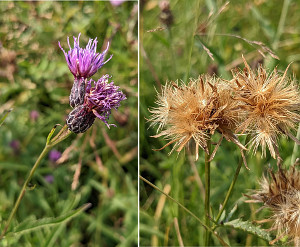 This herb-rich meadow, managed for hay since at least mediaeval times, has been designated a SSSI on account of its wild-flowers.With the summer drought now well advanced, all trace of spring flowers such as Adderstongue Ophioglossum vulgatum and Brown Sedge Carex disticha was gone. Many Summer flowers such as Pepper Saxifrage Silaum silaus were also over, the predominant colour being purple from a mixture of Lesser Knapweed Centaurea nigra and Saw-wort Serratula tinctoria.
This herb-rich meadow, managed for hay since at least mediaeval times, has been designated a SSSI on account of its wild-flowers.With the summer drought now well advanced, all trace of spring flowers such as Adderstongue Ophioglossum vulgatum and Brown Sedge Carex disticha was gone. Many Summer flowers such as Pepper Saxifrage Silaum silaus were also over, the predominant colour being purple from a mixture of Lesser Knapweed Centaurea nigra and Saw-wort Serratula tinctoria.
The flowers of Saw-wort were not easy to pick out among the commoner Knapweed, which they resemble, but the thistle-like fruits with long pappus-hairs stood out.
Rohan Lewis, 16 January 2023
Photos of Saw-wort flowers and fruit credit: Gill Smith
Field Meeting Report, 6 July 2022
Hodgson's Fields, Skeffling
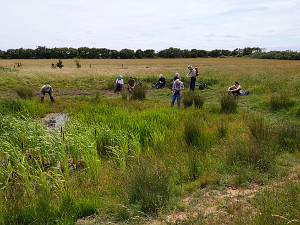 In response to a request from the Yorkshire Wildlife Trust, we visited this reserve, consisting of five fields of relatively unimproved grassland and including a pond and a tiny copse, and were able to supply them with an up-to-date plant list.
In response to a request from the Yorkshire Wildlife Trust, we visited this reserve, consisting of five fields of relatively unimproved grassland and including a pond and a tiny copse, and were able to supply them with an up-to-date plant list.
Photograph - Surveying the pond at Hodgson’s Fields, Skeffling (Yorkshire Wildlife Trust).
Rohan Lewis, 16 January 2023
Two species new to the vice-county
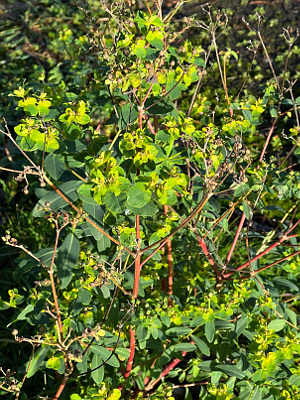 Balkan Spurge Euphorbia oblongata
Balkan Spurge Euphorbia oblongata
A Hull Natural History Society group, on a New Year plant hunt on 3rd January 2022, came across this clump of spurge (photo) on a derelict industrial site in Beverley.The identification was confirmed from the photograph by the BSBI’s Euphorbia referee,Timothy Walker – apparently it is well known for flowering early in the year.
Spreading Mouse-Ear Hawkweed Pilosella flagellaris ssp.flagellaris
In late May 2021, another Hull Natural History Society group exploring the Hornsea Rail Trail near the eastern edge of the city found a small patch of an unusual Pilosella, similar vegetatively and in flower colour to the Common Mouse-Ear Hawkweed Pilosella officinarum, but with taller scapes bearing 2-4 capitula. Their identification of the plant as P. flagellaris ssp. flagellaris using Stace’s flora was later confirmed from a pressed specimen by the BSBI’s Hieracium referee, Brian Burrow.
A recent article in BSBI news (vol.148 pp.54-57) recounts the gradual spread of this plant across Europe from its stronghold in the Carpathian mountains, initially by its introduction into various botanic gardens, from which it then escaped (the first UK record was in 1869, as an escape from the Royal Botanic Gardens, Edinburgh).The article notes an association with old railway lines – true in this case also.
When not in flower, it would not be distinguishable from P. officinarum; when in flower, the phyllaries with sparse, short hairs distinguish it from the hairier ssp. capitata, endemic to the Shetland Isles.
Rohan Lewis, 11 February 2022
Field Meeting Report, 21 July 2021
Bethell’s Bridge, River Hull
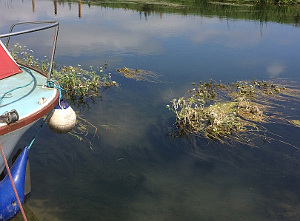 A small group, depleted by a combination of Covid and other commitments, explored the nontidal part of the Hull River and adjacent drains and dykes. Floating Water Dropwort (Oenanthe fluviatilis) was flowering in some quantity among the boats moored at Bethell’s Bridge (photo), while in the Scurf Dike flowers of Arrowhead (Sagittaria sagittifolia), Marestail (Hippuris vulgaris) and both Branched and Unbranched Bur-Reeds (Sparganium erectum and S. emersum) stood out above the various submerged aquatics. Ray Goulder’s expertise was invaluable in identifying the latter which included Pondweeds Potamogeton lucens, P. friesii and P. crispus as well as Fan-leaved Water Crowfoot (Ranunculus circinatus).
A small group, depleted by a combination of Covid and other commitments, explored the nontidal part of the Hull River and adjacent drains and dykes. Floating Water Dropwort (Oenanthe fluviatilis) was flowering in some quantity among the boats moored at Bethell’s Bridge (photo), while in the Scurf Dike flowers of Arrowhead (Sagittaria sagittifolia), Marestail (Hippuris vulgaris) and both Branched and Unbranched Bur-Reeds (Sparganium erectum and S. emersum) stood out above the various submerged aquatics. Ray Goulder’s expertise was invaluable in identifying the latter which included Pondweeds Potamogeton lucens, P. friesii and P. crispus as well as Fan-leaved Water Crowfoot (Ranunculus circinatus).
Rohan Lewis
Field Meeting Report, 23 June 2021
Bail Wood, Aldbrough
A small private block of woodland, designated as an LWS in 2010, probably dating from the very early 1800s, in a part of Holderness where woodland is mostly absent. A dense canopy of Sycamore occupies much of the site, and the species list ran to only 77 plants, but we found single clumps of Lady Fern (Athyrium filix-femina) and Hard Shield-Fern (Polystichum aculeatum) in addition to the more common Broad-Buckler and Male Fern. The only clearing in the wood, made in 2005-06, contained a variety of native tree species planted by the owners, a local Scouting group.
Rohan Lewis
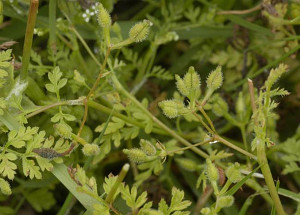 After a cold, late Spring the dearth of plants in flower in this upland Wolds valley was perhaps to be expected, but careful searching and vegetative ID skills yielded a reasonable variety of chalk grassland flora. No searching was required to locate the energetic and very vocal herd of cows in one part of the site – they found us!
After a cold, late Spring the dearth of plants in flower in this upland Wolds valley was perhaps to be expected, but careful searching and vegetative ID skills yielded a reasonable variety of chalk grassland flora. No searching was required to locate the energetic and very vocal herd of cows in one part of the site – they found us!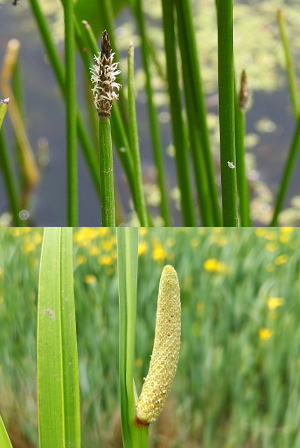 A well-attended meeting in bright spring sunshine began with a walk across the West Park – sheep-grazed and nearly all grass – then a circular walk around the North Lake. Water plants there included Water Horsetail Equisetum fluviatile, Rigid Hornwort Ceratophyllum demersum and three pondweeds Potamogeton natans, P.pusillus and P.crispus. The marginal vegetation on the east side showed signs of excess nutrient enrichment, but Common Spike-rush Eleocharis palustris (top) and a single plant of Skullcap Scutellaria galericulata were found on the western side, with a large stand of Greater Pond-sedge Carex riparia near the central bridge.
A well-attended meeting in bright spring sunshine began with a walk across the West Park – sheep-grazed and nearly all grass – then a circular walk around the North Lake. Water plants there included Water Horsetail Equisetum fluviatile, Rigid Hornwort Ceratophyllum demersum and three pondweeds Potamogeton natans, P.pusillus and P.crispus. The marginal vegetation on the east side showed signs of excess nutrient enrichment, but Common Spike-rush Eleocharis palustris (top) and a single plant of Skullcap Scutellaria galericulata were found on the western side, with a large stand of Greater Pond-sedge Carex riparia near the central bridge.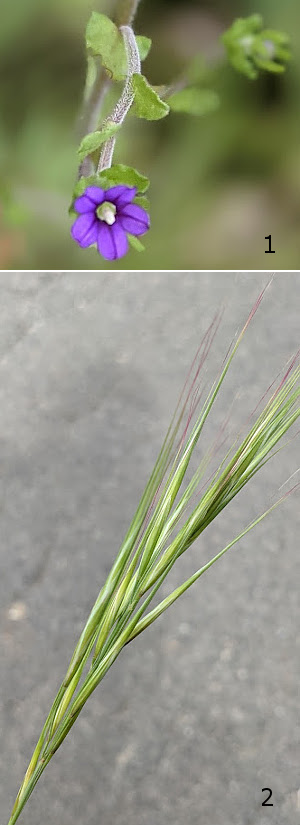 This 1-km length of road verges, on either side of a single-track road on the top of the Wolds, is managed by East Riding Council as a Local Wildlife Site. Despite frequently having to move aside to allow tractors to pass, we managed to record 98 plant species typical of chalk grassland and hedgerow. 19 of these were grasses, including Downy Oat-Grass (Avenula pubescens), Crested Hair-Grass (Koeleria macrantha) and, in a field-margin, the distinctly uncommon Ripgut Brome (Anisantha rigida), spotted by Peter Cook (photo 2). A single bush of a deep pink, glandular dog-rose noticed by Bill Dolling had features of both Rosa sherardii and R. caesia,and might have been the hybrid, previously recorded in the area by Crackles. The adjacent field-margin provided another unexpected find – a small colony of Venus’s Looking-glass (Legousia hybrida) spotted by Gabrielle Jarvis (photo 1).
This 1-km length of road verges, on either side of a single-track road on the top of the Wolds, is managed by East Riding Council as a Local Wildlife Site. Despite frequently having to move aside to allow tractors to pass, we managed to record 98 plant species typical of chalk grassland and hedgerow. 19 of these were grasses, including Downy Oat-Grass (Avenula pubescens), Crested Hair-Grass (Koeleria macrantha) and, in a field-margin, the distinctly uncommon Ripgut Brome (Anisantha rigida), spotted by Peter Cook (photo 2). A single bush of a deep pink, glandular dog-rose noticed by Bill Dolling had features of both Rosa sherardii and R. caesia,and might have been the hybrid, previously recorded in the area by Crackles. The adjacent field-margin provided another unexpected find – a small colony of Venus’s Looking-glass (Legousia hybrida) spotted by Gabrielle Jarvis (photo 1).
 This herb-rich meadow, managed for hay since at least mediaeval times, has been designated a SSSI on account of its wild-flowers.With the summer drought now well advanced, all trace of spring flowers such as Adderstongue Ophioglossum vulgatum and Brown Sedge Carex disticha was gone. Many Summer flowers such as Pepper Saxifrage Silaum silaus were also over, the predominant colour being purple from a mixture of Lesser Knapweed Centaurea nigra and Saw-wort Serratula tinctoria.
This herb-rich meadow, managed for hay since at least mediaeval times, has been designated a SSSI on account of its wild-flowers.With the summer drought now well advanced, all trace of spring flowers such as Adderstongue Ophioglossum vulgatum and Brown Sedge Carex disticha was gone. Many Summer flowers such as Pepper Saxifrage Silaum silaus were also over, the predominant colour being purple from a mixture of Lesser Knapweed Centaurea nigra and Saw-wort Serratula tinctoria. In response to a request from the Yorkshire Wildlife Trust, we visited this reserve, consisting of five fields of relatively unimproved grassland and including a pond and a tiny copse, and were able to supply them with an up-to-date plant list.
In response to a request from the Yorkshire Wildlife Trust, we visited this reserve, consisting of five fields of relatively unimproved grassland and including a pond and a tiny copse, and were able to supply them with an up-to-date plant list. Balkan Spurge Euphorbia oblongata
Balkan Spurge Euphorbia oblongata A small group, depleted by a combination of Covid and other commitments, explored the nontidal part of the Hull River and adjacent drains and dykes. Floating Water Dropwort (Oenanthe fluviatilis) was flowering in some quantity among the boats moored at Bethell’s Bridge (photo), while in the Scurf Dike flowers of Arrowhead (Sagittaria sagittifolia), Marestail (Hippuris vulgaris) and both Branched and Unbranched Bur-Reeds (Sparganium erectum and S. emersum) stood out above the various submerged aquatics. Ray Goulder’s expertise was invaluable in identifying the latter which included Pondweeds Potamogeton lucens, P. friesii and P. crispus as well as Fan-leaved Water Crowfoot (Ranunculus circinatus).
A small group, depleted by a combination of Covid and other commitments, explored the nontidal part of the Hull River and adjacent drains and dykes. Floating Water Dropwort (Oenanthe fluviatilis) was flowering in some quantity among the boats moored at Bethell’s Bridge (photo), while in the Scurf Dike flowers of Arrowhead (Sagittaria sagittifolia), Marestail (Hippuris vulgaris) and both Branched and Unbranched Bur-Reeds (Sparganium erectum and S. emersum) stood out above the various submerged aquatics. Ray Goulder’s expertise was invaluable in identifying the latter which included Pondweeds Potamogeton lucens, P. friesii and P. crispus as well as Fan-leaved Water Crowfoot (Ranunculus circinatus).
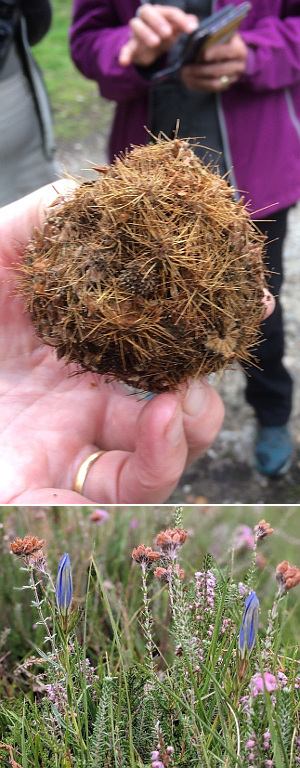 The excursion, led by Sonia Donaghy, was to the western end of this large reserve.The alien Pirri-pirri-bur (Acaena novae-zelandiae), introduced by servicemen from New Zealand during the second world war, is now present on many of the tracks and in wooded areas, spread by grazing sheep which can accumulate large balls of the hooked fruits on their fleece (photo top).Pillwort (Pilularia globulifera) was seen thriving around two of the small ponds, and in one small area of heathland Marsh Gentian (Gentiana pneumonanthe) was in flower (photo).
The excursion, led by Sonia Donaghy, was to the western end of this large reserve.The alien Pirri-pirri-bur (Acaena novae-zelandiae), introduced by servicemen from New Zealand during the second world war, is now present on many of the tracks and in wooded areas, spread by grazing sheep which can accumulate large balls of the hooked fruits on their fleece (photo top).Pillwort (Pilularia globulifera) was seen thriving around two of the small ponds, and in one small area of heathland Marsh Gentian (Gentiana pneumonanthe) was in flower (photo).